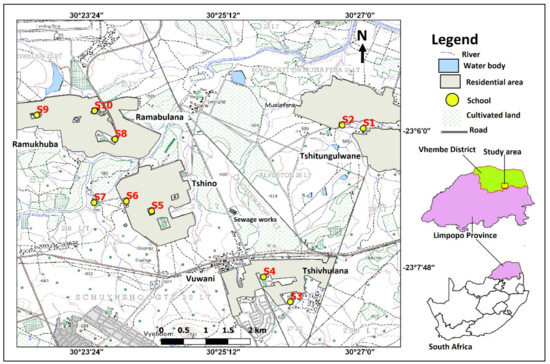Abstract
Public schools in most rural areas of South Africa depend on untreated groundwater due to unreliable water supply by the municipalities. This has the potential to cause water-related health problems to school children. Temperature, pH, and electrical conductivity (EC) were measured in situ. Chemical (fluoride, chloride, sulphate, phosphate, nitrate, magnesium, calcium, sodium, and potassium) and microbial (Escherichia coliform (E. coli), Salmonella typhimurium, and Shigella flexneri) water quality parameters were analysed in groundwater samples from 10 public schools in Vhuronga 1 to determine suitability for use. Quantitative microbial risk assessment was carried out to determine risks of infection and illness due to consumption of groundwater. Correlation analysis was used to identify potential sources of contamination. All physical and most chemical water quality parameters were within guidelines for domestic water use. A high proportion of schools had high levels of microbial organisms. Risks of infection per day were relatively low for all schools. The annual risks of infection due to E. coli and Shigella flexneri for most schools was high, with maximum values of 89.11 and 83.75%, respectively. Maximum risks of illness per year were 31.19, 30.37, and 29.31% for E. coli, Salmonella typhimurium, and Shigella flexneri, respectively. Correlation analysis indicated potential contamination of groundwater by agricultural activities, domestic waste, and faecal contamination from pit latrines. Preventive and mitigation measures to minimise such risks, including locating boreholes at safe distances from pit latrines, prevention/minimisation of pollution of groundwater from agricultural activities, and point-of-use treatment of groundwater by the schools are therefore essential.
Excerpt:
Fifty percent of students from a primary school in Siloam Village, South Africa had mottled teeth due to high fluoride in groundwater
Reference: Odiyo, J.O.; Makungo, R. Fluoride concentrations in groundwater and human health impact in Siloam Village, Limpopo Province, South Africa. Water SA 2012, 38, 731–736. [Google Scholar] [CrossRef]

